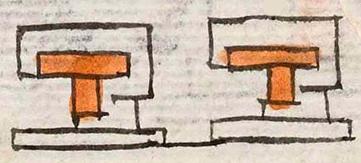Calli Imayan (Mdz10r)
This compound glyph for the place name Calli Imayan (better known as Calimaya today) shows two houses or buildings (calli) that have been arranged in a row (ima(ti)). The buildings are facing to the viewer's left. The buildings are white with a terracotta color given to the t-shaped beams (both vertical and horizontal). The locative suffix (-yan) is not shown visually.
Stephanie Wood
It is tempting to see the "Imayan" as a possessed noun, such as maítl (hand, arm; perhaps building extensions), plus a locative. But, the locative suffix -yan is one that attaches to verbs and indicates customary action. Karttunen wonders if the verb could be "ma," to hunt. But it may be imati. Daniel Brinton's translation of the verb imati, includes this one: "to prepare or arrange something skillfully." [See our Online Nahuatl Dictionary.] Berdan and Anawalt (The Codex Mendoza, 1992, v. 1, p. 175) also support this reading.
Stephanie Wood
cali ymayan. puo
Calli Imayan, pueblo (Calimaya today)
Stephanie Wood
c. 1541, but by 1553 at the latest
Stephanie Wood
houses, buildings, arrangements, in order, building extensions, Calli Imayan, casas, edificios, arreglos, extensiones de edificios, architecture, casas, edificios, arquitectura, poner en orden, -yan locative, nombres de lugares

cal(li), house or building, https://nahuatl.wired-humanities.org/content/calli
ima(ti), to arrange skillfully, https://nahuatl.wired-humanities.org/content/imati
-yan (locative suffix), https://nahuatl.wired-humanities.org/content/yan
Frances Karttunen, who gives the orthographic rendering of this place name as: Calli Imāyān, writes: "I'm stumped. Grammatically it looks like a place where a house/houses customarily hunt. If calli can refer to a group of people who live together, then it would be ok." She is basing this on a reading of the verb as ma, "to go hunting." She says it cannot be a possessed maitl (hand) because -yan is a suffix that attaches to verbs. [Frances Karttunen, unpublished manuscript, used here with permission.]
"Place Where They Put Houses in Order" (Berdan and Anawalt, 1992, vol. 1, p. 175)
"Lugar Donde Ponen Casas en Orden"
Stephanie Wood
Codex Mendoza, folio 10 recto, https://digital.bodleian.ox.ac.uk/objects/2fea788e-2aa2-4f08-b6d9-648c00..., image 30 of 188.
The Bodleian Libraries, University of Oxford, hold the original manuscript, the MS. Arch. Selden. A. 1. This image is published here under the UK Creative Commons, “Attribution-NonCommercial-ShareAlike 3.0 License” (CC-BY-NC-SA 3.0).


